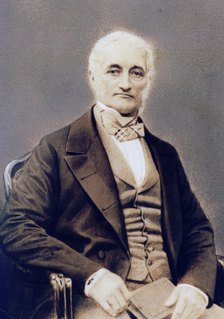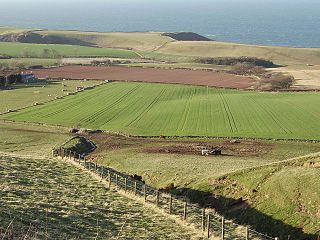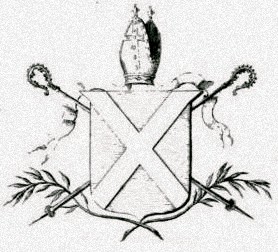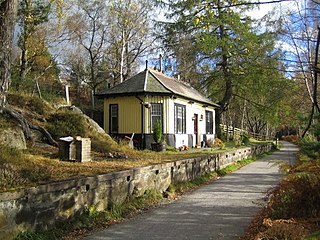
Clackmannanshire is a historic county, council area, registration county and Lieutenancy area in Scotland, bordering the council areas of Stirling, Fife, and Perth & Kinross and the historic counties of Perthshire, Stirlingshire and Fife.

The River Forth is a major river in central Scotland, 47 km (29 mi) long, which drains into the North Sea on the east coast of the country. Its drainage basin covers much of Stirlingshire in Scotland's Central Belt. The Gaelic name for the upper reach of the river, above Stirling, is Abhainn Dubh, meaning "black river". The name for the river below the tidal reach is Uisge For.

Alloa is a town in Clackmannanshire in the Central Lowlands of Scotland. It is on the north bank of the Forth at the spot where some say it ceases to be the River Forth and becomes the Firth of Forth. Alloa is south of the Ochil Hills, 5.5 miles (8.9 km) east of Stirling and 7.9 miles (12.7 km) north of Falkirk; by water Alloa is 25 miles (40 km) from Granton.

Ballater is a burgh in Aberdeenshire, Scotland on the River Dee, immediately east of the Cairngorm Mountains. Situated at an elevation of 213 metres, Ballater is a centre for hikers and known for its spring water, once said to cure scrofula. It is home to more than 1500 inhabitants.

William Burn was a Scottish architect. A talented architect, he received major commissions from the age of 20 until his death at 81. He built in many styles and was a pioneer of the Scottish Baronial Revival.

Siccar Point is a rocky promontory in the county of Berwickshire on the east coast of Scotland. It is famous in the history of geology for Hutton's Unconformity found in 1788, which James Hutton regarded as conclusive proof of his uniformitarian theory of geological development.

Cambusnethan is a large village and suburb on the eastern edge of Wishaw, North Lanarkshire in Scotland. It is approximately 1.5 miles (2.4 km) long, straddling both sides of the A722 on a hill overlooking Wishaw.

Tullibody, is a town set in the Central Lowlands of Scotland. It lies north of the River Forth near to the foot of the Ochil Hills within the Forth Valley. The town is 1.8 miles (2.9 km) south-west of Alva, 1.8 miles (2.9 km) north-west of Alloa and 4.0 miles (6.4 km) east-northeast of Stirling. The town is part of the Clackmannanshire council area.

The A1107 is a road in south-east Scotland, in the Scottish Borders. It is a non-trunk route from near Cockburnspath to near Burnmouth.
The Archdeaconry of Lothian, located in modern-day Scotland, was a sub-division of the diocese of St Andrews, one of two archdeaconries within the diocese and in essence that part of the diocese which lay south of the Forth. The Lothian archdeaconry was headed by the Archdeacon of Lothian, a subordinate of the Bishop of St Andrews.

The Battle of Piperdean was an engagement in the Scottish Borders, fought on 10 September 1435 between the Kingdom of Scotland and the Kingdom of England.

Stagecoach East is the divisional name for the bus operations of the Stagecoach Group in eastern England.

The Diocese or Archdiocese of St Andrews was a territorial episcopal jurisdiction in early modern and medieval Scotland. It was the largest, most populous and wealthiest diocese of the medieval Scottish church, with territory in eastern Scotland stretching from Berwickshire and the Anglo-Scottish border to Aberdeenshire.

Cambus is a village near Alloa, Clackmannanshire. It is located to the south of Tullibody, to the northwest of Alloa, and about 4 miles east of Stirling, across the river. It lies on the River Devon, near its confluence with the River Forth.
The Very Rev James Rae Forgan DD (1876-1966) was a Scottish minister who served as Moderator of the General Assembly of the Church of Scotland in 1940.

Cambus O'May railway station or Cambus O'May Halt, served Aberdeenshire, Scotland from 1876 to 1966 on the Deeside Railway. It was intended to serve the anglers on the River Dee, tourists, the 1874 Cambus O'May House hunting lodge and the local population of this rural district and stood 39 3⁄8 miles (63.4 km) from the Aberdeen (Joint) station. It was the last stop before Ballater.
Cambus railway station served the suburb of Cambus, Clackmannanshire, Scotland from 1852 to 1968 on the Stirling and Dunfermline Railway.

The Cambus O' May bridge spans the River Dee to the east of Ballater, Aberdeenshire. It was paid for by the estate of Alexander Gordon, who had grown up nearby. The bridge was built in 1905 and is a suspension footbridge 164 feet (50 m) long and 4 feet (1.2 m) wide. The bridge was rebuilt in 1988 for safety reasons but was badly damaged in the December 2015 Storm Frank. It was repaired and reopened in April 2021.
















